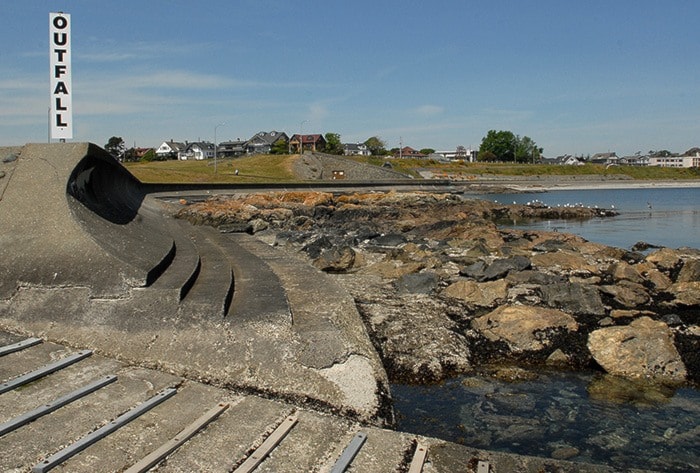Esquimalt citizens recently got a preview of what $20 million in amenities for the community could look like for hosting a wastewater treatment plant at McLoughlin Point.
Now, councillors with the City of Victoria have been given another look at what their amenities could look like as Clover Point moves into the rezoning phase for the Capital Regional District’s (CRD) estimated $765-million project.
Built in 1975, the existing Clover Point pump station requires expansion and upgrades in order to handle the city’s growing population and comply with federal and provincial regulations. A conveyance pipe to pump sewage to the proposed plant in Esquimalt would also need to be constructed along Dallas Road to connect Clover and Ogden points.
The public realm amenities associated with the expansion of the pump station include a list of items such as a public viewing plaza, public washrooms, benches, and intersection improvements at Dallas and Clover Point Road. The CRD is also proposing to build a two-way cycle track over the conveyance pipe, which would include barrier-fencing between the off-leash dog park and the cycle track.
During a meeting Thursday, some councillors expressed concern with the impact the construction would cause in the already congested James Bay neighbourhood, but Elizabeth Scott, deputy project director of the Core Area Wastewater Treatment Project, assured the issue is at the forefront as the project moves into the next stage of construction planning.
“The pipeline will have disruptions and we recognize that, so it’s going to be key to plan how we are going to mitigate those. We’ve heard from a lot of residents and a lot of people are saying just get on and build this project now,” said Scott, who’s also heard confusion from the community about what exactly is planned for Clover Point.
“It’s not going to be adding treatment processing. It’s going to be an expanded pumping station, but instead of pumping the wastewater into the ocean, it’ll be pumped to the wastewater plant at McLoughlin for treatment prior to being discharged.”
City staff noted the design details have yet to be worked out and are far from being finalized. Council also directed staff to include electric car charging stations at Clover Point as discussions on amenities continue, and to hold a community workshop on the design elements and cycle path.
In September, the CRD board voted to build a single 108 megalitre/day plant for the tertiary treatment of wastewater at McLoughlin Point. The federal government has deemed Victoria as high-risk when it comes to its current method of discharging screened sewage into the ocean, therefore the region must move towards secondary sewage treatment by 2020 in order to comply with federal wastewater regulations.
On Jan. 23, citizens of Esquimalt were invited to an open house to comment on community amenities associated with the proposed project that still needs approval from council to be rezoned in order to move forward.
Since October, the township and Core Area Wastewater Treatment Project Board have been negotiating community amenities as part of the rezoning process. So far up to 24 individual amenities have been identified, including $7 million for waterfront parks, $5 million for community recreation buildings and spaces, and $5 million for emergency services and public safety facilities.
The discussions have also resulted in public art possibly being on or off-site within the township, a reduction in size of public open spaces on site and possibly located elsewhere, a green roof rather than a wetland roof on the operations and maintenance building, along with noise and odour control.
A number of amenities will remain from the existing zoning bylaw, including $100,000 towards public art, $75,000 towards public open space, air filter upgrades for local schools and an annual contribution of $55,000 to an operating reserve fund.
So far, Esquimalt Mayor Barb Desjardins likes what she sees.
“We are in a significantly better place than we were years ago in terms of recognition for host community...although there are still some concerns about how it’s allocated, it’s my sense that the community is feeling that the amenity package is a good package,” said Desjardins. “I anticipate it will give benefit not only through the infrastructure but in terms of reducing future tax increases that would have been needed to cover some of those costs (of other township projects).
A public hearing will be held in Esquimalt on Feb. 20, and a final decision on rezoning is slated to be made Feb. 27.
